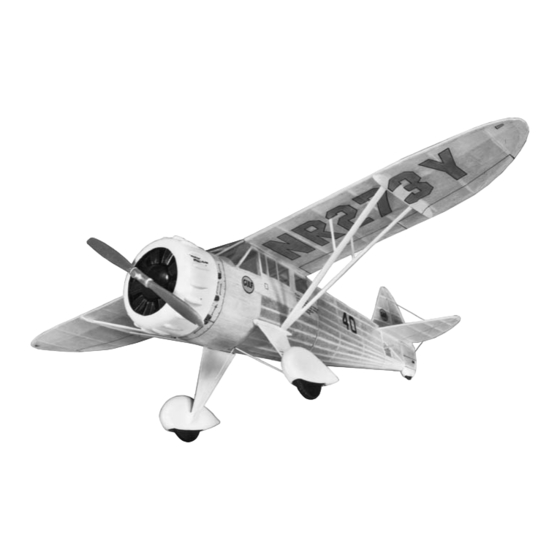
Table of Contents
Advertisement
Quick Links
General Notes
Mr. Mulligan is both an accurate scale model and a high performance flying model. Its lightness contributes to its durability, since
a light model flies slower and if it hits something it does so with less force.
The real Mr. Mulligan was a very successful and unusual racing airplane. It was built in 1934 by Ben Howard. In 1935 it won both
the Bendix Trophy race and the Thompson Trophy race. What made the aircraft so different was that it could carry four people
and luggage yet beat the special purpose single place racing planes of the time. It was also faster than the best Army Air Corps
fighters of its day. In 1936 it lost a propeller blade during the Bendix race and crashed in the mountains of New Mexico. The
remains were recovered by an airline pilot in 1972. Construction of the model is generally conventional but there are a few
unusual features to make it easier to build and stronger. Please read these instructions carefully so that you do not overlook the
unique features and make time consuming errors. Figure A shows the uncovered structure. Begin by building the fuselage, wing
or tail first as preferred.
Fuselage
The sides of the fuselage are built separately, directly over the plan. Pin the 1/16" sheet side pieces to the plan, making
sure you have the proper one on the correct side as they differ slightly around the windows. Add the 1/16" square side
outlines and the rest of the 1/16" square pieces and stringers. Note that the uprights are not added until the sides are
completed and removed from the plans. They go on the side that was next to the plans - on the inside of the fuselage.
This makes the covering smoother.
Advertisement
Table of Contents

Summary of Contents for SIG Mr. Mulligan SIGF23 Classic Series
- Page 1 General Notes Mr. Mulligan is both an accurate scale model and a high performance flying model. Its lightness contributes to its durability, since a light model flies slower and if it hits something it does so with less force. The real Mr. Mulligan was a very successful and unusual racing airplane. It was built in 1934 by Ben Howard. In 1935 it won both the Bendix Trophy race and the Thompson Trophy race.
- Page 2 Join the two sides at the tail at F19. Then cement in F-l between the sides at the front. Note that the sides aren't square in the front, forward of F-3. Be particularly careful that everything is aligned properly at this point so you'll have a straight fuselage.
-
Page 3: Tail Surfaces
Wing Build the center section over the plan, holding parts in place with pins until after the wing is completely assembled. The center section leading edge is 3/32"x3/16". A piece of 1/16" square is glued between the center section ribs and flush with their top surface to provide a place to cement on the three top fuselage stringers (see top view of fuselage on plan) after the completed wing is glued to the fuselage. - Page 4 Now cut out the plastic windshield and carefully try it for fit. Trim where necessary. Use a small amount of Sig-Ment or Contact Cement to attach. Extreme care should be exercised to keep cement from blemishing the windshield.
-
Page 5: Testing And Adjusting
Tie a square knot in the rubber to make a loop. It's best to lubricate it with Sig Rubber Lube. The rubber is installed through the opening in the cowl and held in back with a 1/16" dowel. Contest Tips The Mr. -
Page 6: Preflight Preparations
Preflight Preparations Before you leave the workshop for the flying field, take these important steps. Looking from the front of the model, check that the bottom of the wing and tail surfaces are flat - not twisted. Sight down the center line of the fuselage as shown in the drawing. - Page 7 Stalling If your plane noses up, LOSES SPEED, and then falls clumsily or dives, that is a STALL. To cure a stall, adjust the angle of the stabilizer by changing the thickness of the incidence block under it. Lower the front edge or raise the rear edge.
- Page 8 A plane's weight determines how much power it needs. If your ship is huskier than average, it may not climb, even when fully wound. In that case, add one strand (not a complete loop) of 1/8" Sig rubber to the motor. Tie an eye (like a slip knot) in each end.
-
Page 9: Limit Of Liability
All the models in Sig's Classic series have been carefully designed and flight tested to assure flying ability. Hand wound, you can expect flights of 10 to 25 seconds and stretch wound, 20 to 50 seconds.














Need help?
Do you have a question about the Mr. Mulligan SIGF23 Classic Series and is the answer not in the manual?
Questions and answers